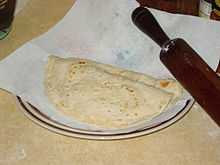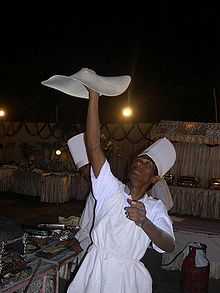Roti
| Roti | |
|---|---|
 | |
| Place of origin: | |
| Indian subcontinent[1] | |
| Region or state: | |
| Indian subcontinent | |
| Main ingredient(s): | |
| atta flour | |
| Variations: | |
| Chapati, Makki di roti, Tandoori roti, Roti canai | |
| Recipes at Wikibooks: | |
|
| |
| Media at Wikimedia Commons: | |
|
|
Roti is generally an Indian bread, made from stoneground wholemeal flour, traditionally known as atta flour, that originated and is consumed in India, Pakistan, Nepal, Sri Lanka and Bangladesh. It is also consumed in parts of South Africa, the southern Caribbean, particularly in Trinidad and Tobago, Guyana, and Suriname, and Fiji. Its defining characteristic is that it is unleavened. Indian naan bread, by contrast, is a yeast-leavened bread. A kulcha in Indian cuisine is a bread-like accompaniment, made of processed flour ("Maida") leavened with yeast.
Various types of roti, are integral to Indian and Pakistani cuisine.[2][3]
Etymology
The word roti is derived from the Sanskrit word रोटिका (roṭikā), meaning "bread".[4] Names in other languages are Hindi: रोटी; Assamese: ৰুটী; Nepali : रोटी; Bengali: রুটি; Sinhala: රොටි; Marathi: पोळी; Oriya: ରୁଟି; Malayalam: റൊട്ടി; Kannada: ರೊಟ್ಟಿ; Telugu: రొట్టి; Tamil: ரொட்டி; Urdu: روٹی; Dhivehi: ރޮށި; Punjabi: ਰੋਟੀ,ਫੂਲਕਾ; Thai: โรตี. It is also known as rotli in Gujarati, maani in Sindhi and phulka in Punjabi and Saraiki.
South Asia
Many different variations of flat breads are found in many cultures across the globe, from South Asia to the Americas. The traditional flat bread originating from the South Asia is known as roti; pronounced "rho tee". It is normally eaten with cooked vegetables or curries; it can be called a carrier for curries or cooked vegetables. It is made most often from wheat flour, cooked on a flat or slightly concave iron griddle called a tawa. Like breads around the world, roti is a staple accompaniment to other foods. In Iran, the two variants of this bread are: khaboos[5] and lavash. These two breads (the former of which is almost exactly prepared like Indian roti) are quite similar to other South Asian rotis.
In Sri Lanka, probably the most popular type of roti is pol roti (coconut roti), made of wheat flour, kurakkan flour or a mixture of both, and scraped coconut. Sometimes, chopped green chillies and onion are added to the mixture before cooking. These are usually thicker and harder than other roti types. They are usually eaten with curries, or some types of sambol or lunu miris and considered a main meal rather than a supplement.
Southeast Asia


In Indonesia, Malaysia, and Somalia, the term encompasses all forms of bread, including western-style bread, as well as the traditional Punjabi breads.
In Thailand, "โรตี" refers to the maida paratha—known in Indonesia as roti maryam, roti cane or roti konde, Malaysia as roti canai and in Singapore as roti prata—which is sometimes drizzled with condensed milk, rolled up, and eaten as a hot snack, or fried with egg as a larger dish.
West Indies
In the West Indies, roti is referred to in two ways; first as its native South Asian name "roti" by those of South Asian descent and second as roti used as wrap with any sort of savory stuffing, by those of non-South Asian descent who may not have had close interactions with the South Asian (Indian) community. The traditional way of eating roti amongst those of South Asian descent is to break the roti with their hands and to use it to sop up curry or stew. To those of non-South Asian descent this is a foreign practice and hence their perception of the commercialized wrapped roti as the representative standard of "roti"
The "roti wrap" is the commercialization of roti and curry as a fast-food item in the Caribbean. The wrap roti originated in southern Trinidad. It was first created in the mid-1940s by Sackina Karamath who later founded Hummingbird Roti Shop in San Fernando, Trinidad, to make it easier and faster to eat the items, as the individuals' hands would not get as dirty. In Trinidad and Tobago, various wrapped "roti" are served, including chicken, conch, beef, and vegetable. Shrimp and goat are also available. Because the roti acts as a wrap, numerous combinations can be made, but the most popular tend to be curried items.
As South Asian Guyanese and Trinidadians moved to other Caribbean islands or to North American cities such as Toronto, New York, and Montreal, they exported with them the commercialized idea of a wrapped roti. This has become the version that some people of non-South Asian descent know as roti. The growth in popularity of the commercial wrapped roti, in more recent times, saw reference by some individuals and restaurants/commercial companies of a plain roti by itself as a "roti shell or skin". This incorrect reference is done as a means to either dumb down or appease those of non-South Asian descent who may not have taken the time to educate themselves on the correct cultural representation/meaning of roti.
Various types of roti feature prominently in the diets of those of South Asian descent within West Indian countries, especially Trinidad and Tobago, Guyana and Suriname. West Indian roti are primarily made from wheat flour, baking powder, salt, and water, and cooked on a tawa. Certain rotis are also made with butter. Several types of roti are made in Guyana, Trinidad, and where ever else South Asians settled.
| Food | Description | |||||||||||||||||||||||||||||||||||||||||||||||||||||||||||||||||||||||||||||||||||||||||||||||||||
|---|---|---|---|---|---|---|---|---|---|---|---|---|---|---|---|---|---|---|---|---|---|---|---|---|---|---|---|---|---|---|---|---|---|---|---|---|---|---|---|---|---|---|---|---|---|---|---|---|---|---|---|---|---|---|---|---|---|---|---|---|---|---|---|---|---|---|---|---|---|---|---|---|---|---|---|---|---|---|---|---|---|---|---|---|---|---|---|---|---|---|---|---|---|---|---|---|---|---|---|---|
| Sada roti | This is a plain roti, made of white flour. Because it is the simplest roti to make, it is the most commonly consumed roti in Trinidad. It is a popular breakfast option in Trinidad, in combination with various vegetable, curry and meat dishes. This type of roti is the staple carbohydrate consumed for both breakfast and dinner by many South Asian Trinidadians. | |||||||||||||||||||||||||||||||||||||||||||||||||||||||||||||||||||||||||||||||||||||||||||||||||||
| Paratha roti | A roti of layers made with butter, usually ghee (Clarified Butter) but any butter can be used with it, the roti is put onto the tawa and butter is spread out onto it, partha eventually turns brown, and has more taste than the plain traditional roti, paratha is traditionally eaten with fried eggs and/or a cup of tea. Ghee is rubbed on both sides, then it is cooked on tawa (a round, flat metal griddle used in Indian cooking). This gives the roti a crisp outside. When it almost finished cooking, the cook begins to beat the roti while it is on the tawa, causing it to crumble. In Trinidad the commercial term used by non-South Asians for paratha is 'Buss-Up-Shut". | |||||||||||||||||||||||||||||||||||||||||||||||||||||||||||||||||||||||||||||||||||||||||||||||||||
| Puri | A roti where two layers are rolled out together and cooked on the tava. It is also rubbed with oil while cooking. This type of roti is eaten in Guyana with a special halva when a child is born. | |||||||||||||||||||||||||||||||||||||||||||||||||||||||||||||||||||||||||||||||||||||||||||||||||||
| Dhalpuri[6] | A roti with a stuffing of ground yellow split peas, cumin (geera), garlic, and pepper. The split peas are boiled until they are al dente and then ground in a mill. The cumin is toasted until black and also ground. The stuffing is pushed into the roti dough, and sealed. When rolled flat, the filling is distributed within the roti. It is cooked on the tava and rubbed with oil for ease of cooking. | |||||||||||||||||||||||||||||||||||||||||||||||||||||||||||||||||||||||||||||||||||||||||||||||||||
| Wrap roti | A popular wrap made by folding curry, stew, vegetables or combination thereof inside of a Dhalpuri roti. Curry or stew normally contains potatoes and a meat of some sort like chicken, goat, beef or shrimp. | |||||||||||||||||||||||||||||||||||||||||||||||||||||||||||||||||||||||||||||||||||||||||||||||||||
| Piper roti | A wrap roti that usually contains only potatoes and gravy, and scrap meat. Piper roti got its name by being a cheaper alternative to purchasing a regular roti. The term "piper" is the local slang used to describe a drug addict; most of his money is spent on drugs and the little he has remaining will purchase food. | |||||||||||||||||||||||||||||||||||||||||||||||||||||||||||||||||||||||||||||||||||||||||||||||||||
| Aloopuri | A roti similar to a Dhalpuri but with aloo (potato) substituted for the dhal. The aloo is boiled, milled and spices and seasonings are added before being sealed in the dough. This aloo filling is also used when making aloo pie or aloo choka. | |||||||||||||||||||||||||||||||||||||||||||||||||||||||||||||||||||||||||||||||||||||||||||||||||||
 Guyanese roti, clapped and ready to be eaten. Depending on where Indians settled in Guyana, foods can be different. In some parts of Guyana, Dosti Roti is made. South Asian Guyanese food as a whole can be different from their South Asian Trinidadian brothers, including the names of many items.
In Suriname roti refers mainly to dhalpuri or aloopuri. It is most often eaten with curried chicken. Roti can also refer to a dish of stuffed and spiced roti wraps. It is custom to eat this dish by hand. Due to mass emigration of Indian Surinamese in the 1970s, roti became a popular take-out dish in the Netherlands. It usually includes chicken curry, potatoes, a boiled egg and various vegetables, most notably the kousenband or yardlong bean. Another variation includes shrimp and aubergine. The meat with gravy, potatoes, egg and yardlong beans are served side by side on a plate, with the aloopura folded in fours on top. One then has the option to spice the dish with a very hot chutney made of Madame Jeanette peppers. Other dishes A roti wrap with cream cheese and smoked chicken. .jpg) 2 rolls of lamb roti roll Roti, pronounced "Rooti" in Cape Town, is also a staple food source amongst many of the Indian, Asian and Cape coloured communities living in South Africa and is either eaten as a flat bread or a wrap with locally made curries. See also
References
External links
| ||||||||||||||||||||||||||||||||||||||||||||||||||||||||||||||||||||||||||||||||||||||||||||||||||||







